
Scorpions are predatory arachnids of the order Scorpiones. They have eight legs, and are easily recognized by a pair of grasping pincers and a narrow, segmented tail, often carried in a characteristic forward curve over the back and always ending with a stinger. The evolutionary history of scorpions goes back 435 million years. They mainly live in deserts but have adapted to a wide range of environmental conditions, and can be found on all continents except Antarctica. There are over 2,500 described species, with 22 extant (living) families recognized to date. Their taxonomy is being revised to account for 21st-century genomic studies.

Reginald Innes Pocock F.R.S. was a British zoologist.

The Buthidae are the largest family of scorpions, containing about 100 genera and 1339 species as of 2022. A few very large genera are known, but a high number of species-poor or monotypic ones also exist. New taxa are being described at a rate of several new species per year. They have a [cosmopolitan] distribution throughout tropical and subtropical environments worldwide. Together with four other families, the Buthidae make up the superfamily Buthoidea. The family was established by Carl Ludwig Koch in 1837.
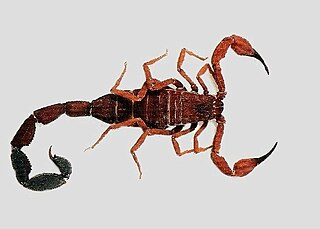
Tityus is a large genus of thick-tailed scorpions, the namesake of its subfamily Tityinae. As of 2021, Tityus contains more than 220 described species distributed in Central America and South America, from Costa Rica to Argentina. Species in the genus Tityus have been studied for hundreds of years, long before the taxonomic classification was put in place. Tityus tend to be of medium size for scorpions, roughly 50 to 70 millimeters long. They are dark brown or red in color, and can exhibit sexual dimorphism. They can live in a variety of environments, ranging from urban to arid mountains to the Amazon Rainforest. Tityus scorpions are best known for their venom and potent sting. The genus contains several dangerously venomous scorpions, the best known of which is the Brazilian yellow scorpion, T. serrulatus. Its venom can cause severe illness, and in the young, old and infirm even death. Some experts have argued that the genus as a whole may be paraphyletic, which could explain the knowledge gaps related to Tityus.
The taxonomy of scorpions deals with the classification of this predatory arthropod into 13 extant families and about 1,400 described species and subspecies. In addition, 111 described taxa of extinct scorpions are known.
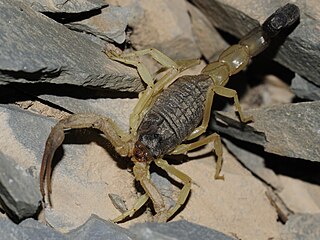
Hottentotta is a genus of scorpions of the family Buthidae. It is distributed widely across Africa, except for most of the Sahara desert. Species in the genus also occur in the Middle East, the Arabian Peninsula, southeastern Turkey, Iraq, Iran, Afghanistan, Pakistan, India, Nepal, Cape Verde Islands, and Sri Lanka (introduced).
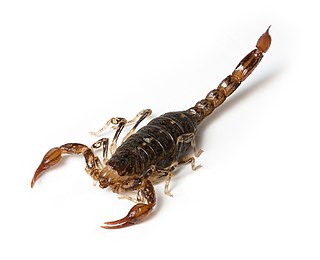
The Bothriuridae are a family of scorpions, comprising 151 species in 16 genera.
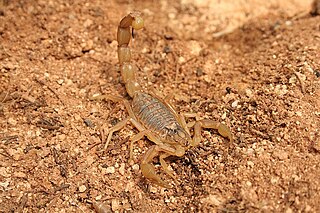
Buthus is a genus of scorpion belonging and being eponymous to the family Buthidae. It is distributed widely across northern Africa, including Morocco, Mauritania, Algeria, Tunisia, Libya, Egypt, Senegal, Guinea-Bissau, Nigeria, Sudan, Somalia, Ethiopia, Djibouti, as well as the Middle East, including Israel, Palestine, Jordan, Lebanon, Iraq, Yemen, and possibly Saudi Arabia and southern Turkey. Its European range includes the Iberian Peninsula, southern France, and Cyprus.

Chaerilus is a genus of scorpions in the family Chaerilidae. They live in tropical parts of South Asia and Southeast Asia. A fossil genus Electrochaerilus is known from the Late Cretaceous (Cenomanian) aged Burmese amber.
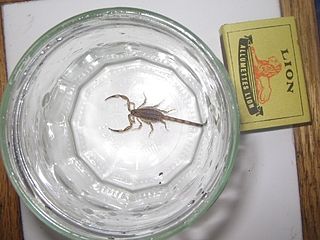
Isometrus is a genus of scorpion belonging and being eponymous to the family Buthidae. Some species are currently assigned to the genus Reddyanus.

The Chactidae are a family of scorpions established by Reginald Innes Pocock in 1893. They make up the superfamily Chactoidea.

The Euscorpiidae are a family of scorpions.

Opisthacanthus is a genus of scorpions in the family Hormuridae occurring in Central and South America, the Caribbean, Africa and Madagascar.
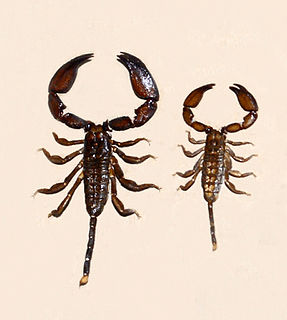
Liocheles australasiae, the dwarf wood scorpion, is a species of scorpion belonging to the family Hormuridae.

Scorpiops is a genus of scorpions in the family Scorpiopidae. It is distributed throughout much of Asia. The taxonomy of the group is unclear because new species and subgenera are described often, and one subgroup may represent a species complex.
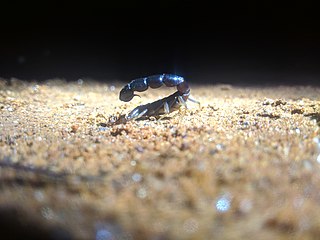
Buthoscorpio is a genus of scorpions in the family Buthidae.
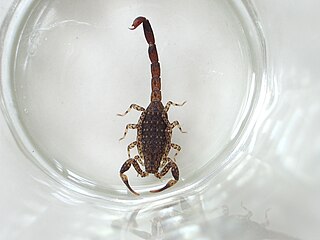
Lychas is a genus of scorpions belonging to the family Buthidae. It is one of the most widespread genus of the scorpions, where the species are found throughout in Africa and Seychelles, and in the Oriental region from India to Melanesia.

Charmus is a genus of buthid scorpions native to India and Sri Lanka.

Reddyanus is a genus of buthid scorpions native to Oriental region from India, Sri Lanka, China: Tibet, to Melanesia. The genus was previously described as a subgenus of Isometrus.


















